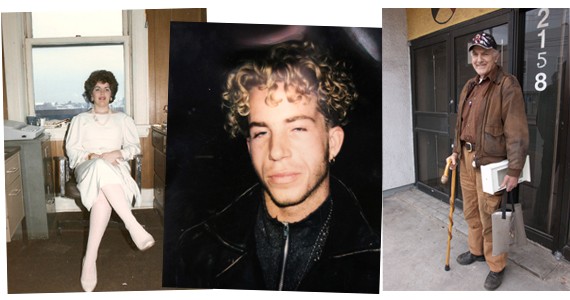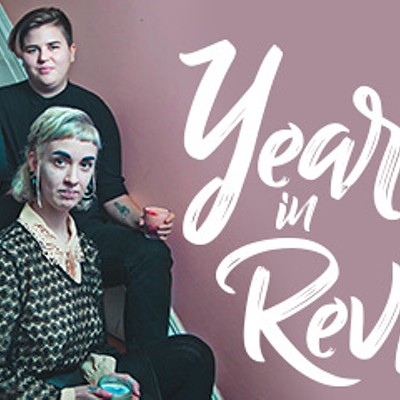[ Jump to: Anne Derrick | Fred Connors | Robin Metcalfe | Mike Clattenburg
Stephanie Bertossi | Jane Wright | Mike Campbell | Bill Lewis ]
Anne Derrick
Through many trials, Halifax barrister-turned-judge remains committed to social justice.
The expressionist swirls of a painting by a Laing House social worker hang to the left of judge Anne Derrick in her office at the Halifax Provincial Court. The painting was chosen for the cover of her 400-page inquiry into the death of Howard Hyde, a Nova Scotia man with schizophrenia who died after a scuffle with guards in his jail cell.
Hyde was tasered with stun guns, up to five times, 30 hours before he died. In her 2010 report, Derrick warned against using conducted energy weapons on emotionally agitated people except in the rarest of circumstances. She wrote that there should be more mental health training for front-line police officers, correctional officers, sheriffs and other participants in the criminal justice system.
She urged the province to increase funding for all levels of a significantly underfunded mental health care system. Stigma plays a large part in criminalization, she says. Although areas like housing or therapy are lacking in our response to the needs of people with mental health issues, the criminal justice system immediately responds when there is conflict with the law. The Mental Health Court in Dartmouth is not a panacea to the problem---it did not help Hyde, who was doubly stigmatized as a forensic hospital patient and a mental health patient.
Derrick recognizes the importance of social support work and peer advocacy, "to try and support people and to avoid them getting into conflict with the law as Hyde did." Meaningful work is the best way to break the stigma, she says, so a person is not defined only by their mental illness.
"There but for fortune, go I," she quotes, her desk sprawling with neat piles of paperwork, each held fast by an elegant crystal paperweight.
Not for a second has Derrick regretted her career choice. She was appointed to the bench in 2005 after over two decades of service as a social justice advocate lawyer. She keeps going because of the resilience of her clients. Her role in the Donald Marshall case is a case in point.
Donald Marshall Jr. was wrongfully convicted of murder and spent 11 years of a life sentence in jail before he was acquitted by the Nova Scotia Court of Appeal in 1983. Derrick found the decision seriously flawed as co-counsel for Marshall during the 1989-90 Royal Commissions on his prosecution.
Marshall always carried the scar of wrongful conviction with him, says Derrick. "He was always haunted by it. It didn't crush him but it certainly injured him."
Looking back 20 years, Derrick, who worked for an all-female law firm when she was admitted to the bar, recalls her decisive victory for abortion rights in the landmark R. v. Morgentaler case.
Doctor Henry Morgentaler, charged with performing seven illegal abortions at his clinic in Halifax in 1989, was acquitted of all charges in a decision upheld by the Supreme Court of Nova Scotia in 1993. It was an attempt on the part of the province to circumvent access to abortion, a matter of federal jurisdiction.
There have been no criminal laws regulating abortion since the decision. --Rana Encol
Fred Connors
A hurricane jump-started his whirlwind journey
from entrepreneur to politician.
As the owner and namesake behind FRED, Fred Connors has made his presence in Halifax known. With a commitment and passion towards the Halifax community and developing the north end, Connors has amassed a solid number of loyal supporters.
"I was growing my business on Barrington just down the street from where The Coast was growing their business," says Connors of his first salon. "But I saw all of my creative and talented friends leaving Halifax because there were no opportunities for them. I knew I had to not be afraid to provide the opportunities I needed for myself."
Connors recalls a transformative moment, when he decided there was more he could be doing to live up to his own expectations. "When The Coast was a new publication, their best-of issue was something like the top 100 people that make Halifax happen, where they profiled 100 people in Halifax who were making a difference. They simply asked me for a photo of myself," says Connors. "I had no idea what it was for, and when I saw my face on the cover of that newspaper, with all of those other people who were doing unique and interesting things that contributed socially and culturally to the community, I thought, 'Wow, maybe I have something to offer that I don't think I have.'"
His Barrington Street spot was devastated by Hurricane Juan, but Connors saw the setback as opportunity. He bought the old Bank of Nova Scotia building on Agricola and turned it into FRED. "I believe the universe came together and gave me a giant kick on the ass," says Connors. "I had no pre-existing vision of the north end, and I didn't give a shit about the community. I moved into this location purely because it was cheap. We decided to put in this weird, crazy combination of beauty, food and gallery space for local artists and create this very diverse, interactive space. We became the living room of the north end."
Last fall, Connors ran for mayor of HRM. He didn't win, but was pleased to be able to start a conversation. "One of the things I wanted to demonstrate was that you don't need to be an old white dude to be a political candidate," says Connors. "My focus was to make my vision for my community known to people---and to shake it up a little. I honestly believe my presence made it a hell of a lot more interesting." —Jessica Jay
Robin Metcalfe
The art curator is also a vital queer activist.
For the last nine years, Robin Metcalfe has been at the helm of the Saint Mary's University Art Gallery as its curator. But in the city he is also well-known for his role helping to establish the LGBTQ community. As he told The Coast in 2001, Metcalfe sometimes feels like the elephant in the parable about blind men who only know the bit of the beast they're touching: "There are people within the gay community who know me, but don't know I have anything to do with art. And there are people who know me as a curator, but have no idea about my work as an activist."
Metcalfe is originally from Chester but grew up all over Atlantic Canada. He came out in 1974 and arrived in Halifax to study at NSCAD. "The gay community in Halifax, which had started to get organized, had gone into a bit of a lull at that time and when I tried to contact the organization, it wasn't there," he says His natural inclination was to get involved and resuscitate it.
"I knew before I came out that it was going to be all or nothing. I knew that if I was going to be out, I was going to be activist," he says. "So when I finally got in touch with the Gay Alliance for Equality, within a couple of weeks I was making a presentation to a parliamentary committee, and then I was flying to Ottawa to attend the national lesbian and gay rights conference, so I sort of just jumped in the deep end."
Although the last 20 years have seen plenty of challenges for Halifax's queer community, there have been victories, too.
"It was in 1997 when I organized an exhibition called Queer Looking, Queer Acting, and that was at Mount Saint Vincent University art gallery," says Metcalfe. "I think it's fair to say that was the first major group show in Halifax that actually focused on issues of queer identity, and it had quite a strong community response."
Metcalfe is excited by the work the current queer community is doing. "The thing that I find most encouraging is the emergence of a new generation of queer activists. And a new emphasis, new focus in queer activism, for example the emergence of a young trans community, particularly trans men. The subject identity of being a trans man that I see now around me is something that would have been almost unimaginable 40 years ago," says Metcalfe. "Now it seems to be that that community is one of the most politically active and contains some of the most really interesting young activists. There's a real interest in connecting with their elders, in connecting with history."
As for the media's reflection of the queer community in Halifax, Metcalfe has been a friend of The Coast for many years.
"When I left for London in 2001, some of my friends in the cultural community and the queer community organized a big event as a going away party and The Coast did a profile on me and the fact I was leaving the city," he recalls. "But The Coast has always been an important source of information and I think recognition for people in the queer community and the cultural community. It helps you believe that you're real if you can see your own image reflected in media." —Chelsea Gutzman and Jessica Jay
Mike Clattenburg
A product of the local film scene, the Trailer Park Boys
creator is now an inspiration for other aspiring filmmakers.
"Twenty years ago, the Nova Scotia film industry was much smaller," says Mike Clattenburg. "There may have been one full crew in town but people mostly worked on outside films that came here. Now there are so many filmmakers making great films here."
Credit Clattenburg himself for much of that transformation.
When Clattenburg first caught the filmmaking bug, he used the Atlantic Film Festival to develop his skills. "I made a bunch of short films and learned a lot watching them with an audience," he says.
In 1998, Clattenburg submitted the well-received One Last Shot, a short staring Robb Wells, John Dunsworth and John-Paul Tremblay. The up-and-comer wanted to repeat that success with the same three actors the following year.
"Many things," explains Clattenburg, "pointed me to a trailer park setting---Hip Club Groove"---the Truro hip-hop band had recently released an album called Trailer Park Hip Hop---"the TV show Cops, Beck, Eminem and no budget."
But it took a little pressure from the law to bring it all to fruition. Clattenburg and his crew ran into trouble with the cops for shooting around town at night in Clattenburg's car, "AKA The Shitmobile," so they were forced to find a legitimate set.
"The trailer park was a free set available to me," he says.
And so, Trailer Park Boys was born, as a black-and-white full-length feature film, Clattenburg's first. TPB was basically a farce version of Cops. "It was Cops, but from a criminal's point of view," he says.
The film was a resounding success at the Atlantic Film Festival. In 2001, TPB was transformed into a half-hour television series, aired on Showcase. Ever since, it's been nothing but success for Clattenburg. But besides TPB's obvious triumphs, the show also allowed Clattenburg to stay in the city he loves---Halifax.
"I was fortunate that I didn't have to leave because of Trailer Park Boys. We did the first film, seven seasons, two one-hour specials, and now three motion pictures, so that spanned about 12 years or so," he says. "Halifax is a great home base for me. I hope I'm able to stay and make films here forever. I like to work elsewhere from time to time, but it's hard for me to leave this place."
Clattenburg has a high opinion of the local film industry.
"More growth is great," he says, "but I think it's doing quite well as it is. The Atlantic Film Festival thrives every year with sold out screenings and a lot of people are working in the industry here. Of course it would be great if there was more money and production, but I think we get a fair shake compared to the rest of the country."
While Clattenburg is quick to boast about the quality and successes of the Nova Scotia TV and film industry as a whole, he modestly downplays the influence he may have on aspiring filmmakers.
"Maybe a few people say, 'If he can do it, I can do it,'" he allows. --Jessica Jay
Stephanie Bertossi
A pioneer in authentic Italian food and fine restaurants.
The Bicycle Thief, il Mercato, Ristorante a Mano and the new La Frasca Cibi & Vini...yes, they are some of Halifax's finest dining experiences, but more importantly, they'e all owned by the same husband and wife duo: Stephanie and Maurizio Bertossi.
The Bertossi dynasty of Italian restaurants began in 1984 when the couple moved back to Halifax from Calgary. "We were living in Calgary and looking to open a restaurant there, but then we came back here on holidays and Maurizio just said 'I think we should open a restaurant in Halifax,'" recalls Stephanie. "And so we moved back and we built and opened our first restaurant, La Perla. "It was an eight-table restaurant. I remember my aunt made the drapes, that kind of thing, you know, it wasn't fine dining. It was just a beautiful old room up on Alderney Drive that we made a restaurant in."
Though the food's quality would have likely led the Bertossis to success almost anywhere in the world. That they were first in a lot of ways helped ignite the immediate success of La Perla, Bertossi speculates. "The extent of word of mouth in this city is very powerful, and we brought stuff to the city that no one else had before---authentic Italian food, everything made by hand. We made the bread, we made the deserts, we made every soup, stalk and sauce---we made everything, and in the '80s that was kind of unheard of."
Since the Bertossis began cooking up homemade sensations, more Halifax restaurateurs have been serving up their own takes on authentic, home-cooked cuisine. "We've been in this industry for almost 30 years, so we certainly have done a lot. But the whole dining scene has changed. We have tons of great people in the city that are doing all kinds of interesting things. It's not about fine dining or anything in particular. It's a whole blend of what people are doing now," Bertossi says. "You can do whatever it is you love."
The Bertossis' next endeavour is the transformation of il Mercato into La Frasca: "il Mercato was always a superb restaurant but we really thought it was time to bring something new to Spring Garden Road. La Frasca is just our next great adventure. That's what we call them each and every time, because it's always an adventure and we love it." --Kaitie Unwin
Jane Wright
jane's on the common made a home for neighbourhood restos.
Twenty years ago Jane Wright was working a nine-to-five job as a labour relations consultant for the provincial NDP. Now, she is known throughout Halifax as the pioneer of cozy and affordable, yet exquisite, neighborhood dining.
The idea for jane's on the common came to Wright on March 1, 2003. By September, the restaurant was up and running. "Within five months I had quit my job, got the lease and renovated and opened jane's," Wright says.
Her inspiration came from "one of those mid-life crisis moments when you realize life is short and you better figure out what you really want to do on this earth because you don't really have a lot of time," she explains. "I always described it as, I wanted my day to involve joy," she says.
The idea was to combine local ingredients to create unique recipes and comfort-food classics with a twist, within an affordable range, the kind of place people could dine for breakfast, lunch and dinner if they wanted to---a neighbourhood spot. "For years Halifax had two extremes---there was fine dining and there was, you know, fish and chips. When I opened jane's I really wanted to make sure it was accessible. The price point and the quality, that's what I was after, that middle ground."
Though Wright is modest about her accomplishments within the restaurant industry, to the rest of us it's clear that she did something special for Halifax dining. A particular article in The Coast helped even Wright pay attention to her own successes. "I was on the cover once, which was the greatest thing in my life. My cover picture on The Coast came out three weeks before my mother died and I got it to her in Ottawa. You have no idea how much that meant to me because I was always the black sheep of the family and then finally my mother had this validation that I had done something."
Since the opening of jane's, unique neighbourhood restaurants keep popping up, including one of the newest---Edna, at 2053 Gottingen Street, is owned and operated by Wright's daughter, Jenna Mooers. After the closure of jane's last December, Edna is the haunt the neighbourhood's been pining for.
"It was a really hard thing to close that restaurant," says Wright. "I miss it, the customers miss it. It was a huge part of me." --Kaitie Unwin
Mike Campbell
From Much reporter to Carleton owner, always a scene supporter.
Twenty years ago, when you changed the channel of your 18-inch, non-flat screen TV to MuchMusic, you might have seen Mike Campbell hosting one of his three national hit shows. Today, you'll find him at the heart of downtown Halifax running The Carleton.
Throughout Campbell's career he's done almost every job there is within the music industry---including an 18-year stint with Much, during which he travelled Canada countless times. It was a combination of seeing so many different cities and an undying love for live music that led Campbell to open The Carleton in Halifax, where he'd been based (and featured on a 1995 Coast cover) as host of MuchEast. "Because I'd spent so much time in various places across the country, I'd been to almost every venue, and ate in a million restaurants," he says. "The bottom was starting to basically fall out of the music industry, so as sort of a Plan C in the back of my brain I always thought, 'If worse comes to worst I can always open up a restaurant or a bar.' Thinking, yeah, that's easy to do."
And so The Carleton was born. It wasn't supposed to be the listening room-style bar it is today. "I was really just interested in opening up a cool bar with great food, and I just sort of vaguely had a plan of maybe putting in one really good artist a month, just to spice it up," Campbell explains. But immediately after its opening, The Carleton suffered one stroke of bad luck after another.
First, the Chronicle-Herald relocated its 500 employees---and their solid lunch business---from across the street from The Carleton to an insurance company's building off the peninsula. About three months after that, the recession hit. Watching these misfortunes, Campbell quickly realized that simply offering a good atmosphere with good eats wasn't going to cut it.
"I started to turn more and more to trying to find good entertainment," he says, "because when I did that people would buy tickets and come in for dinner." It was the night of The Carleton's debut live show, featuring Joel Plaskett, that the restaurant gained the reputation of being a listening room.
"I think I was just worried that maybe we'd have some people that wouldn't appreciate what was happening on the stage, so I made a point before the first show of telling everyone to be quiet and got a big round of applause," Campbell says. "I've been making the speech ever since. But again, it wasn't like I said, 'I'm going to open a listening room in Halifax,' it just sort of evolved into that, which I'm really happy about because I think it's something that the city needs. In the end I guess it was kind of an accidental good move."
But despite finding a niche and surviving through some tough times, Campbell says running The Carleton is a continuous struggle. Whether people simply can't afford it, or there are just too many different entertainment options, Campbell is sad to say he feels few people share his desire to see a good live show, which is unfortunate since the talent pool is so strong. "From my perspective we probably have more talent here right now in the city than we ever had---even back in the good ol' days when Sloan was still living here," he says, laughing.
So Campbell and The Carleton will keep on keepin' on, providing Halifax and its artists with a venue that has great eats, super sound and a comfortable atmosphere. "I've got a lot of time and emotional energy wrapped up in this city, and I have my fingers crossed that it's going to bounce back one of these days. I'm just hoping I'm still alive to see it." —Kaitie Unwin
Bill Lewis
Native advocate says solutions lie in traditional spiritual practices
and respect for the Earth.
Bill Lewis---who has seen everything from the 1963 March on Washington to Oka to Occupy---was nearly one of the infamous Butterbox babies. The Ideal Maternity Home in East Chester, Nova Scotia was anything but a perfect home for unwed mothers when Lewis’ mom, a Mi’kmaq woman, arrived in 1935. Keeping her baby was a brave decision because of the stigmatization of having a child out of wedlock, reflects Lewis. His father was Cree, from out west.
Many babies from the maternity were sold on the black market to families in New England. Babies considered “unmarketable” were dumped in the ocean or buried in an adjacent cemetery---hence the term “butterbox,” referring to the wooden dairy crates which served as the ungodly coffins for these orphans. Fortunately for Lewis, he was saved by a woman named Rachel Marshall, from the Millbrook reserve. Lewis returned to Halifax after he was discharged from the segregated prison in Lethbridge, Alberta, where he kicked his heroin habit in solitary confinement. Tragicomic, then, that his first job in Halifax was at a mental institution in Cole Harbour. Lewis recounts his political awakening coinciding with the expropriation of Africville residents’ land. He was then working as a hand on sailboats, listening to Radio Havana via pirate radio.
Lewis sits on the board for the Mi’kmaq Native Friendship Centre, which serves an estimated 5,000 urban aboriginals residing in Halifax. The Friendship Centre movement strives to offer educational, cultural, rehabilitation and support services to those disconnected from their home communities across the country. In light of state-drawn divisions among natives---status vs. non-status or reservation vs. off-reserve, for example---the centre offers a unifying sense of place and purpose intrinsic to the spirit of the Idle No More and Solidarity movements. Lewis advocates for traditional healing and spirituality for his people so that the practices and foundations for healing remain when funding is low.
He describes the sweat lodge as a return to Mother Earth. The ceremony brings together people and nature as one, a chance to celebrate “All my relations” or “M’sit no’kama.” Tobacco is given in thanks, and unlike commonplace addictions to nicotine and coffee, tobacco rituals are observed conscientiously: “That’s the difference between perfunctory rituals and sacred rituals,” he explains.
He advocates for the long-term ecological oversight by native elders, just as an Onondaga Nation chief once wrote of considering not one generation, but seven generations at a time. Lewis’ small red day planner is a testament to the daily minutiae of the social work built on generations of struggle. “Whatever was going on 20 years ago was going on 10, 20 years before that,” he says. Just because the story isn’t on the front page doesn’t mean the struggle is over; just as with the seasons, sometimes there is a time to rest.
But Lewis remains ever vigilant.
He was one of a handful of people in the room when Manny Jules and former Conservative policy adviser Tom Flanagan visited Dalhousie and returned to Ottawa saying they had consulted with Aboriginal communities on forthcoming omnibus legislation. Lewis disagrees: Jules and Flanagan did not publicize the visit and their presentation was riddled with misinformation---“underhanded propaganda,” says Lewis.
Among other things, they were trying to peddle “matrimonial property rights,” which Lewis describes as Orwellian legislation designed to privatize property on reserves and expedite the process of mineral and gas exploitation.
Lewis is quick to point out the irony.
“They say they’re doing this in the name of protecting women, when women have to appeal every single [court] decision, when they won’t do an inquiry into missing and murdered indigenous women.” --Rana Encol
















